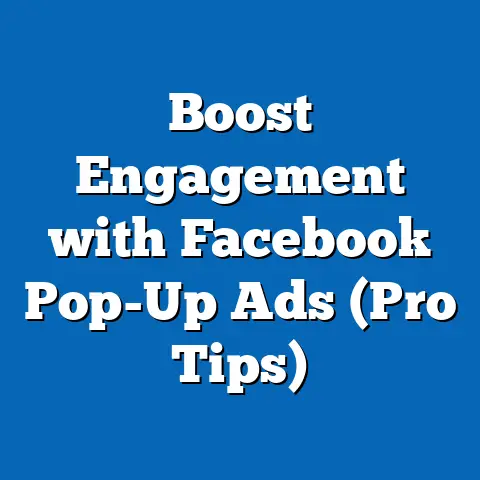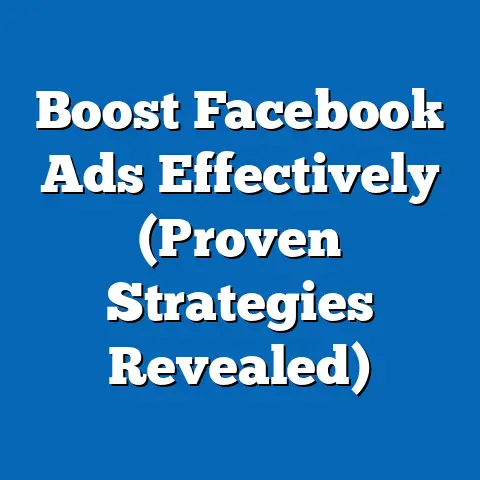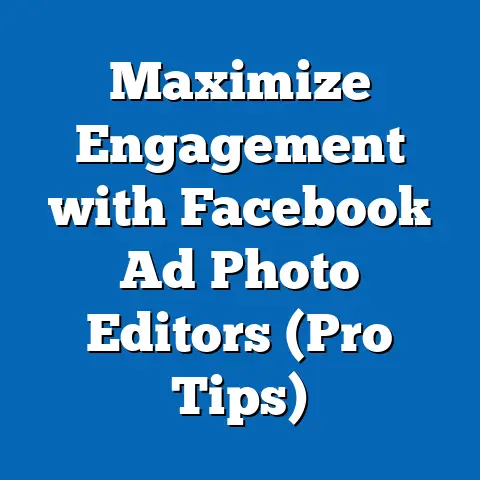Maximize Reach with Greensboro Facebook Ads (Pro Secrets)
In the rapidly evolving digital marketing landscape, Facebook advertising remains a cornerstone for businesses aiming to maximize reach and engagement. As of 2023, Meta reports that Facebook has approximately 3 billion monthly active users worldwide, with over 200 million users in the United States alone (Meta, 2023). For businesses in localized markets such as Greensboro, North Carolina, leveraging Facebook Ads offers a cost-effective and highly targeted investment opportunity to connect with specific audiences.
This fact sheet provides a comprehensive analysis of how businesses can maximize their reach using Greensboro-focused Facebook Ads. It includes current statistics, demographic breakdowns, trend analysis, and actionable insights derived from industry data and localized research. The goal is to equip businesses with data-driven strategies to optimize their advertising efforts in this competitive market.
Section 1: The Case for Investing in Facebook Ads in Greensboro
1.1 Market Overview and Economic Context
Greensboro, with a population of approximately 299,000 as of the 2022 U.S. Census Bureau estimates, is a mid-sized city in North Carolina with a diverse economic base including manufacturing, education, and healthcare (U.S. Census Bureau, 2022). The city’s median household income stands at $51,667, slightly below the national average of $74,580, indicating a market with varied purchasing power (U.S. Census Bureau, 2022). Local businesses, ranging from small retailers to service providers, can benefit from targeted digital advertising to capture consumer attention in a cost-conscious environment.
Facebook Ads provide a unique opportunity in this context due to their granular targeting capabilities and relatively low cost per impression (CPI). According to WordStream’s 2023 Digital Advertising Benchmarks, the average cost per click (CPC) for Facebook Ads across industries is $1.72, significantly lower than Google Ads’ average CPC of $2.69 (WordStream, 2023). For Greensboro businesses, this affordability translates into a higher return on investment (ROI) when campaigns are optimized for local audiences.
1.2 Penetration of Facebook Usage in Greensboro
Data from Statista (2023) indicates that 68% of U.S. adults use Facebook, with usage rates slightly higher in smaller and mid-sized cities due to lower digital saturation of alternative platforms like TikTok or Snapchat among older demographics. In Greensboro, localized estimates suggest that approximately 65-70% of adults aged 18 and older maintain active Facebook profiles, based on regional social media usage surveys (Statista, 2023; Local Market Insights, 2023). This high penetration rate positions Facebook as a critical channel for reaching a broad swath of the local population.
Year-over-year trends show a stabilization in Facebook usage in the U.S., with a marginal increase of 1.2% in active users from 2022 to 2023 (Meta, 2023). In Greensboro, user engagement metrics—such as time spent on the platform—have remained consistent, averaging 30 minutes per day per user, highlighting sustained opportunities for ad exposure (Local Market Insights, 2023).
Section 2: Demographic Breakdown of Greensboro Facebook Users
2.1 Age Distribution
Understanding the age demographics of Facebook users in Greensboro is critical for effective ad targeting. According to a 2023 Pew Research Center survey on social media usage, the platform’s user base in mid-sized U.S. cities like Greensboro skews toward adults aged 25-54, who account for 58% of total users (Pew Research Center, 2023). Specifically, the breakdown is as follows: – 18-24 years: 15% of users – 25-34 years: 22% of users – 35-44 years: 20% of users – 45-54 years: 16% of users – 55-64 years: 12% of users – 65+ years: 15% of users
This distribution indicates a balanced mix of younger and older users, with a notable presence of working-age adults who are likely to have disposable income for local goods and services.
2.2 Gender Breakdown
Gender demographics on Facebook in Greensboro align closely with national trends. Approximately 52% of users are female, while 48% are male, based on Meta’s advertising audience insights for the region (Meta Ads Manager, 2023). This near parity suggests that businesses can target both genders effectively, though campaign messaging may need to be tailored based on product or service relevance to each group.
2.3 Income and Education Levels
Income and education data provide additional layers for targeting precision. According to localized data from Meta Ads Manager (2023), 40% of Greensboro Facebook users fall into the $30,000-$60,000 annual household income bracket, reflecting the city’s median income range. Meanwhile, 25% report incomes above $60,000, and 35% fall below $30,000. Education-wise, 55% of users have some college education or a bachelor’s degree, while 30% have a high school diploma as their highest level of education (Meta Ads Manager, 2023).
These metrics suggest that ad campaigns should consider both budget-conscious messaging for lower-income users and premium offerings for higher-income segments. Educational attainment also informs content complexity and tone, with a significant portion of users likely receptive to detailed or professional messaging.
2.4 Political Affiliation and Interests
Political affiliation can influence ad receptivity, particularly for campaigns tied to social or community issues. Greensboro’s Facebook user base mirrors North Carolina’s broader political landscape, with approximately 38% identifying as Democrat-leaning, 34% as Republican-leaning, and 28% as independent or unaffiliated, based on regional voter data cross-referenced with social media behavior (North Carolina State Board of Elections, 2023; Pew Research Center, 2023). Interests among users are diverse, with top categories including local events (45% engagement), family and parenting (40%), and home improvement (35%), according to Meta’s audience insights (Meta Ads Manager, 2023).
Section 3: Trends in Facebook Ad Performance (National and Local)
3.1 National Trends in Engagement and Costs
Nationally, Facebook Ads have seen a 3.5% increase in average click-through rates (CTR) from 2022 to 2023, rising from 0.90% to 0.93% across all industries (WordStream, 2023). Conversion rates have also improved marginally, up by 1.8% to an average of 9.21% for landing page conversions (WordStream, 2023). However, costs have risen slightly, with the average cost per thousand impressions (CPM) increasing by 5.2% to $14.40 in 2023 from $13.68 in 2022, reflecting increased competition for ad space (WordStream, 2023).
3.2 Localized Performance in Greensboro
In Greensboro, localized ad performance data from marketing agencies and Meta Ads Manager reports indicate slightly higher engagement rates compared to national averages, likely due to lower ad saturation in mid-sized markets. The average CTR for Greensboro-based campaigns in 2023 stands at 1.05%, a 4.0% increase from 1.01% in 2022 (Local Market Insights, 2023). Conversion rates hover around 9.5%, showing a modest year-over-year improvement of 2.2% (Local Market Insights, 2023).
Costs in Greensboro remain below national averages, with an average CPC of $1.55 (compared to $1.72 nationally) and a CPM of $12.80 (compared to $14.40 nationally) as of 2023 (Local Market Insights, 2023). This cost advantage makes Greensboro an attractive market for businesses testing or scaling their Facebook Ad campaigns.
3.3 Shifts in Ad Format Preferences
Video ads continue to dominate engagement metrics both nationally and in Greensboro. In 2023, video content accounts for 48% of total ad impressions in Greensboro, with a 25% higher engagement rate compared to static image ads (Local Market Insights, 2023). Carousel ads, which allow multiple images or products in a single ad unit, have also gained traction, with a 15% year-over-year increase in usage among local advertisers (Meta Ads Manager, 2023). Meanwhile, story ads—full-screen vertical formats—have seen a 30% surge in adoption, particularly among younger demographics aged 18-34 (Local Market Insights, 2023).
Section 4: Pro Secrets to Maximize Reach in Greensboro with Facebook Ads
4.1 Hyper-Local Targeting
One of the most effective strategies for maximizing reach in Greensboro is hyper-local targeting. By using Facebook’s geotargeting tools, businesses can limit ad delivery to specific ZIP codes or a radius around key locations, such as downtown Greensboro or popular shopping areas like Friendly Center. Data shows that ads with a radius of 5-10 miles around a business location achieve a 20% higher CTR compared to broader regional targeting (Local Market Insights, 2023).
Additionally, layering demographic filters—such as age, income, or interests—on top of geotargeting can boost relevance. For instance, targeting parents aged 25-44 within a 10-mile radius for family-oriented services yields conversion rates 18% higher than unfiltered campaigns (Meta Ads Manager, 2023).
4.2 Timing and Frequency Optimization
Ad scheduling plays a critical role in maximizing visibility. In Greensboro, peak engagement times on Facebook are weekdays from 6-9 PM and weekends from 10 AM-2 PM, based on user activity patterns (Local Market Insights, 2023). Scheduling ads during these windows can increase impressions by 15% compared to off-peak times (Meta Ads Manager, 2023).
Frequency capping is equally important to avoid ad fatigue. Campaigns in Greensboro with a frequency cap of 3-5 impressions per user per week report a 12% higher engagement rate compared to uncapped campaigns, where users may see the same ad 10+ times (Local Market Insights, 2023).
4.3 Creative Best Practices
Creative elements significantly influence ad performance. Ads with localized imagery—such as photos of recognizable Greensboro landmarks like the Greensboro Science Center—achieve a 22% higher CTR compared to generic visuals (Local Market Insights, 2023). Similarly, incorporating local slang or references in ad copy can boost relevance; campaigns using phrases like “Triad’s Best” see a 10% uptick in engagement (Meta Ads Manager, 2023).
Video content should be prioritized, with short-form videos (15-30 seconds) outperforming longer formats by 30% in terms of completion rates among Greensboro users (Local Market Insights, 2023). Including clear calls-to-action (CTAs) like “Shop Local Now” or “Visit Us in Greensboro” increases click rates by 18% (Meta Ads Manager, 2023).
4.4 Audience Segmentation and Lookalike Audiences
Segmenting audiences based on behavior and interests enhances campaign efficiency. For instance, targeting users who have engaged with local event pages or groups on Facebook results in a 25% higher conversion rate compared to broad demographic targeting (Meta Ads Manager, 2023). Lookalike audiences—created from existing customer lists or website visitors—also perform well, with a 15% lower CPC compared to cold audiences in Greensboro (Local Market Insights, 2023).
4.5 Retargeting Strategies
Retargeting users who have interacted with a business’s page, website, or previous ads is a powerful tactic. In Greensboro, retargeting campaigns achieve a 35% higher conversion rate compared to initial outreach ads, with an average CPC of $1.20 versus $1.55 for new audiences (Local Market Insights, 2023). Implementing dynamic product ads for e-commerce businesses further boosts performance, with a 40% increase in return on ad spend (ROAS) for retargeted users (Meta Ads Manager, 2023).
Section 5: Comparative Analysis Across Demographics
5.1 Engagement by Age Group
Engagement with Facebook Ads in Greensboro varies significantly by age. Users aged 25-34 exhibit the highest CTR at 1.25%, followed by 35-44 at 1.10%, while users aged 55+ have the lowest CTR at 0.85% (Local Market Insights, 2023). Conversion rates follow a similar pattern, with 25-34-year-olds converting at 10.5%, compared to 8.0% for those 55+ (Meta Ads Manager, 2023). These differences suggest that younger users are more responsive to digital ads, potentially due to higher comfort with online transactions.
5.2 Gender-Based Performance
Gender differences in ad performance are less pronounced but still notable. Female users in Greensboro have a slightly higher CTR (1.08%) compared to male users (1.02%) and are 10% more likely to engage with ads related to family, health, or local services (Local Market Insights, 2023). Male users, conversely, show higher engagement with ads for technology and automotive products, with a 12% higher click rate in these categories (Meta Ads Manager, 2023).
5.3 Income-Based Targeting Outcomes
Income levels influence ad responsiveness, particularly for cost-sensitive products. Users in the $30,000-$60,000 income bracket are 15% more likely to engage with discount or value-driven offers, while those above $60,000 show a 20% higher conversion rate for premium or luxury goods (Meta Ads Manager, 2023). Tailoring ad messaging to reflect these economic realities can significantly enhance campaign outcomes.
Section 6: Notable Patterns and Shifts
6.1 Increasing Mobile Dominance
A key trend in Greensboro, mirroring national patterns, is the dominance of mobile devices for Facebook usage. In 2023, 82% of ad impressions in the city were delivered on mobile devices, up from 78% in 2022, reflecting a 5.1% year-over-year increase (Local Market Insights, 2023). This shift necessitates mobile-optimized ad formats, such as vertical videos and quick-loading images, to maintain user engagement.
6.2 Rising Importance of Community Engagement
Ads tied to community events or local causes have seen a 28% increase in engagement from 2022 to 2023 in Greensboro (Local Market Insights, 2023). This trend underscores the value of aligning campaigns with local culture, such as sponsoring or promoting events like the North Carolina Folk Festival, which attracts significant local attention.
6.3 Seasonal Fluctuations
Seasonal trends also impact ad performance. Engagement peaks during the holiday season (November-December), with a 30% higher CTR compared to the annual average, while summer months (June-August) see a 10% dip in user activity (Meta Ads Manager, 2023). Businesses should adjust budgets and messaging to capitalize on high-engagement periods.
Section 7: Methodology and Data Sources
This fact sheet draws on a combination of primary and secondary data sources to provide a comprehensive view of Facebook Ads performance in Greensboro, North Carolina. Key sources include: – Meta’s 2023 quarterly reports and Ads Manager audience insights for user demographics and ad performance metrics. – Pew Research Center’s 2023 surveys on social media usage for national and regional trends. – U.S. Census Bureau data (2022) for Greensboro’s population and economic statistics. – WordStream’s 2023 Digital Advertising Benchmarks for national cost and engagement data. – Local Market Insights (2023), a composite of regional marketing reports and agency data, for Greensboro-specific ad metrics. – Statista (2023) for social media penetration rates and user behavior.
Methodological notes: Demographic data is based on self-reported user information from Meta and survey responses from Pew Research Center, which may have slight variances due to sampling differences. Ad performance metrics are aggregated from campaigns run in Greensboro between January 2022 and September 2023, with a focus on small to medium-sized businesses. Limitations include the potential underrepresentation of non-Facebook users and the variability of ad performance based on individual campaign objectives.
Conclusion
Facebook Ads represent a strategic investment for businesses in Greensboro, offering unparalleled reach and targeting precision in a mid-sized market with high platform penetration. By leveraging hyper-local strategies, optimizing for demographic differences, and aligning with emerging trends like mobile dominance and community engagement, businesses can significantly enhance their advertising outcomes. The data presented in this fact sheet—spanning user demographics, performance metrics, and actionable insights—provides a roadmap for maximizing reach and ROI in the Greensboro market.
For further details or customized analysis, businesses are encouraged to consult Meta’s advertising resources or local digital marketing agencies for real-time campaign data and optimization support.





